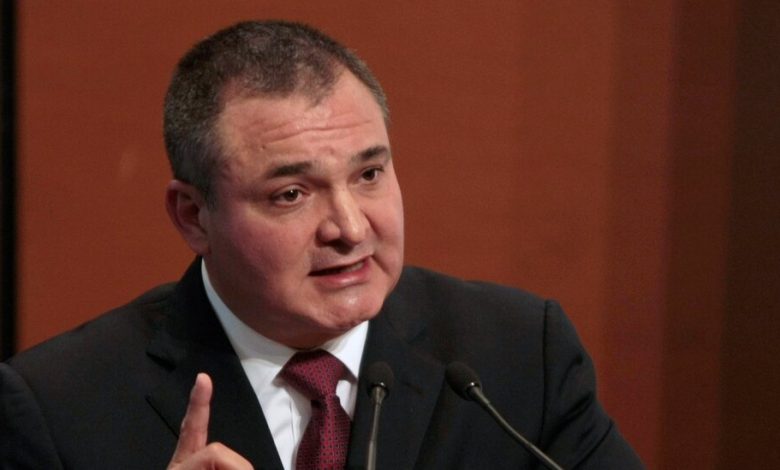U.S. Officials and Mexican Ex-Lawman Convicted of Corruption Met Often, Records Show

Even after Genaro García Luna, who once served as the architect of Mexico’s war on drugs, was found guilty last winter of taking millions of dollars from the drug lords he was meant to be pursuing, one question that lingered from his trial was just how closely he had interacted with United States officials at the time he was supposedly taking bribes.
On Friday, his lawyers offered an answer.
They filed court papers saying that Mr. García Luna met with top American diplomats, law enforcement officers and intelligence officials more than 180 times from 2007 to 2012 — a period when a New York jury determined that he had been committing federal crimes.
While serving in the highest circles of Mexico’s national security establishment, the court papers say, Mr. García Luna met 24 times with American ambassadors, eight times with the attorney general, 15 times with C.I.A. officials and almost 50 times with the Drug Enforcement Administration, largely with the agency’s regional director.
The papers also say that both the D.E.A. and the C.I.A. conducted thorough background checks on Mr. García Luna and members of his staff and found no evidence of corruption.
“Mr. García Luna and his team were extensively vetted and cleared of any wrongdoing by the United States government,” the lawyer, César de Castro, wrote.
As Mr. de Castro added, “Surely the United States would not have shared sensitive intelligence and national security information for years with someone they did not trust.”
The papers, filed in Federal District Court in Brooklyn, were part of a request by Mr. de Castro to obtain a new trial for his client based on what he said was newly discovered evidence. After Mr. García Luna was found guilty in February, several witnesses came forward to aid in his defense, including some from Mexico who had been silent during the trial “for fear of reprisal,” Mr. de Castro wrote.
Among the pieces of new evidence obtained by the defense, he said, were daily schedules kept by Mr. García Luna’s aides while he was serving as Mexico’s public security secretary, a powerful cabinet-level post.
Mr. de Castro said he also got his hands on official records signed by a top D.E.A. official and the Mexican attorney general documenting that “the United States government performed extensive background investigations” of Mr. García Luna and his staff that included lie detector tests.
Moreover, Mr. de Castro said, the defense found records showing that 25 officials who worked for Mr. García Luna were vetted by the C.I.A. and were trained in Washington, among other places, to monitor and analyze the activities of drug cartels, and share their findings with American authorities.
“Having members of his department vetted by and working for the C.I.A. explains why the United States government trusted Mr. García Luna with sensitive information and responsibilities, despite the rumors of corruption in the Mexican government,” the filings said.
Mr. de Castro contends that prosecutors improperly withheld some of these records from him even though he specifically requested them from the government nine months before the trial took place. “These materials would have been essential to the defense and could have led to a different result,” he wrote.
Mr. García Luna maintained his innocence during the trial.
Obtaining a new trial is a difficult proposition, largely because judges are generally wary of overturning a jury’s verdict. Mr. de Castro is likely to face an uphill battle in persuading Judge Brian M. Cogan, who oversaw Mr. García Luna’s trial, to grant a new one, even though the court papers he filed claimed that some government witnesses had lied in court the first time.
The conviction of Mr. García Luna, the highest-ranking Mexican official to be tried on drug charges in the United States, was a signal moment in the history of the cross-border war on drug cartels. In Mexico, it was widely seen as a cathartic spectacle in which a top government official was finally held accountable for his many years of corruption.
Mexicans have long suspected that those at the highest levels of power have been in league with the very gangsters who for decades have inflicted pain and suffering on their country. The bitterness and disappointment have been heightened by the fact that despite billions of dollars and decades of efforts by law enforcement on both sides of the border, the violence in Mexico has reached new heights in recent years.
The García Luna trial seemed at first like it might shed some light on the mystery of how a man who “was showered with praise from every corner of United States law enforcement and political communities,” as Mr. de Castro wrote, could at the same time have been getting giant payoffs from the gangsters of the Sinaloa drug cartel, one of Mexico’s most powerful drug mafias.
But even though the witnesses in Brooklyn included former cartel operatives, onetime Mexican police officials and even a man who had once served as the United States ambassador to Mexico, the question of what American officials knew about Mr. García Luna’s ties to the cartels was largely left unresolved.
Prosecutors will now get to respond to Mr. de Castro’s allegations. After that, Judge Cogan will decide on whether or not to grant a new trial in a process that could take several weeks.




